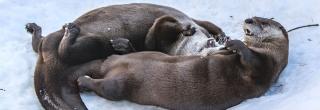
River Otter
| Scientific Name | Lontra canadensis |
|---|---|
| General Description | The river otter is a large, semi-aquatic member of the weasel family weighing from 9 - 41 pounds. Total body length of adult otters ranges from 35 - 54 inches, with long muscular tails accounting for 35 to 40 percent of the total length. Fur coloration usually is dark brown on the back with a lighter belly and throat. Otters are good swimmers, having a long streamlined body, short powerful legs and webbed feet. |
| Status | Year-round resident. |
| Abundance | Uncommon. |
| Primary Habitat | River otters are found in a variety of aquatic habitats, including rivers, streams, backwater sloughs, wetlands, lakes and ponds. Key factors that determine habitat use include food availability (primarily fish and crustaceans), year-round water supplies and adequate cover. |
| Federal Status | No federal status. |
| Reason for Designation | Historically, river otters occurred in aquatic habitats throughout North Dakota, but had declined or disappeared. A study of otters in eastern North Dakota resulted in documentation of a population. More information is needed to re-evaluate their status. |
Locations and Conditions of Key Habitat
Preferred Habitat
In Midwestern states, landscapes that characterize high-quality river otter habitat include a relatively high number of wetlands and high percentage of woodland or riparian habitat within about 300 yards of a river or stream. Otters often are found in aquatic habitats associated with beaver activity and in shallow pools or below small dams where fish are concentrated. Habitats that retain open water in winter are important to otters for acquiring food. Otters den in riparian vegetation, undercut banks, abandoned beaver bank dens and lodges, rock cavities, log jams, and tree root structures.
Key Areas and Conditions for River Otter in North Dakota
The Red River of the North and its tributaries are important waterways for this species. Otters will also use adjacent wetlands and lakes. Reports of otters in the Missouri River do occur but a population has not been identified to date.
Problems Which May Affect this Species
Habitat
The greatest threat to river otters is destruction or modification of riparian habitat for the purposes of economic or housing developments, recreation, or for conversion to cropland.
Other Natural or Manmade Factors
Aquatic habitats where river otters have been sighted and other water bodies throughout North Dakota have documented pollution issues (i.e., dissolved oxygen, sediment, nutrient and heavy metal levels) that could impact survival of otters by reducing prey availability or impairing reproduction. River otters are susceptible to human-caused mortality, including incidental trapping and collisions with vehicles.
Research and Survey Efforts
Current Research or Surveys
- Currently there is no research targeting river otters within the state.
Previous Research or Surveys
- Frostburg State University studied otters and other mesocarnivores in eastern North Dakota from 2008 to 2012.
- Frostburg State University surveyed otters in western North Dakota tributaries in 2012.
- Sightings are recorded by NDGFD staff. Necropsies are performed on incidental catches or vehicle-hit otters.
Additional Research or Surveys Needed
No additional research has been identified.
Management Recommendations
- Protect rivers, streams, and riparian areas where possible (i.e. easements and/or acquisition).
- Work with partners to ensure Swampbuster provisions are maintained.
- Continue to use the Section 404 program to ensure affected rivers and riparian areas are mitigated to replace form and function.
- Continue to work with other federal agencies (i.e. FAA and FHWA) not covered by Section 404 or Swampbuster to ensure affected rivers and riparian areas are mitigated to replace form and function.
- Continue to work with NDSWC to develop minimum in-stream flow recommendations.
- Develop and promote incentive programs to restore riparian areas.
- Develop and promote incentive programs to enhance or restore riparian areas.
- Continue to work with ND 319 Task Force in prioritizing projects within impaired watersheds and implementing BMP’s.
- Work to modify dam operation regimes.
- Develop and promote incentive programs for adjacent landowners to improve bank stability through land use changes (e.g. RRBRP).
- Promote non-traditional bank stabilization measures (i.e. root wads, willow waddles, vegetative slope)
- Control noxious weeds through biological and chemical methods.
- Cooperate with fisheries division on state aquatic nuisance species plan.
- Continue to work with partners in promoting and distributing educational materials related to river, stream and riparian values and good stewardship.
Monitoring Plans
The NDGFD rare furbearer reporting system along with information obtained from incidental trapping is being used to monitor river otter. A standardized survey method such as the one developed by Frostburg State University could be used to gather more information if needed.
2005-2015 Progress
The river otter maintains a level II Species of Conservation Priority ranking. SWG’s T-12-R Evaluating the Distribution and Abundance of River Otters and Other Meso-carnivores in Eastern North Dakota Drainage: Applications of GIS, Genetic and Digital Technologies for Conservation Planning and T2-6-R Evaluating the Distribution of River Otters and Beavers throughout the Missouri and Souris River Drainages in North Dakota have provided much needed information on the species distribution within the state as well as food habits and habitat preferences. The framework for monitoring this species was also developed if additional monitoring is necessary.

Note: A listing of works consulted when compiling the information on this page may be found in the 2015 State Wildlife Action Plan.
